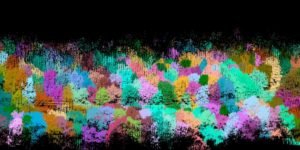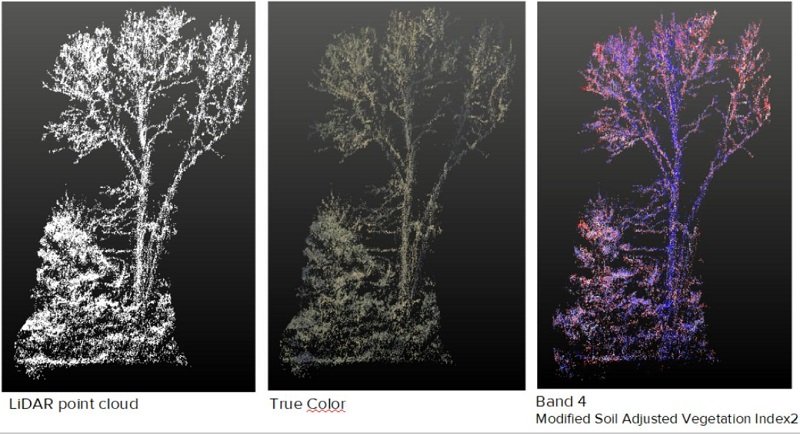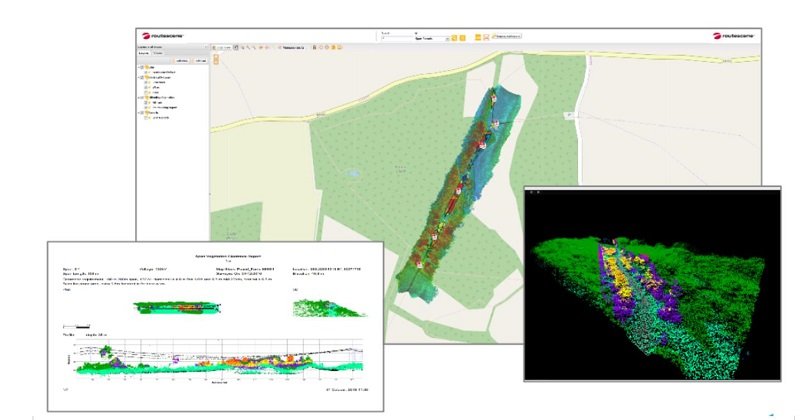 Routescene case study demonstrates the benefits of using drones to manage powerline vegetation.
Routescene case study demonstrates the benefits of using drones to manage powerline vegetation.
by DRONELIFE Staff Writer Ian M. Crosby
The latest in a series of forestry based case studies conducted by Routescene showcases the value of remote sensing techniques like UAV LiDAR for identifying diseased or damaged trees and overgrown vegetation close to powerlines to prevent outages or forest fires.
The project at Pound Farm in Suffolk, UK sought to identify ailing trees and overgrown vegetation that posed a risk of damaging the 33kV power lines running through the 120 acre forest. Routescene collaborated with 2Excel Geo, Fera Science and Dielmo 3D in order to provide the results to the Woodland Trust that owns the land.
In recent years, the forest has been affected by the highly destructive fungal disease known as Ash dieback. Capable of killing ash trees quickly, its symptoms include a blackening and wilting of leaves in mid to late summer.
 LiDAR, RGB, Multispectral and Hyperspectral imaging techniques were each employed to determine their ability to identify signs of Ash dieback.
LiDAR, RGB, Multispectral and Hyperspectral imaging techniques were each employed to determine their ability to identify signs of Ash dieback.
The vegetation penetration capabilities of the Routescene LiDAR system allowed for the compilation of a profile of individual trees from ground level to the canopy to examine health. Density analysis of the LiDAR data gathered from the crown of the trees was to be used to identify disease. LiDAR was also able to easily capture the thin powerlines to establish the proximity of surrounding vegetation.
In-depth processing of the LiDAR data was conducted with Routescene’s LidarViewer post- processing software . The team created a Digital Terrain Model (DTM) to locate power lines and pylons and a Digital Surface Model (DSM) to ascertain the height of the trees. This was used to calculate the normalized height and help identify individual trees.
“The high density point cloud from the Routescene UAV LiDAR system facilitated the improved detection of individual trees within the woodland,” stated Dr. Chloe Barnes of 2Excel Geo. “The structural information provided by the LiDAR also provided complimentary datasets to the spectral information from the airborne imagery for tree health and species classification.”
The addition of RGB imagery made it easy to view the colour of the leaves to determine tree health. Merging RGB imagery with LiDAR data gave each LiDAR point an RGB value, to colourise the point cloud, providing true colour to the LiDAR images that render them easier to interpret.
Hyperspectral and Multispectral imaging data was gathered by light aircraft and drones. Used to capture data beyond the range of human vision, when statistically analyzed this data can help to identify the species, health and stress of the trees. 18 vegetation indexes were used to check tree health, including the Normalised Difference Vegetation Index (NDVI), which is a function of red and near-infrared energy that can indicate leaf area index, plant biomass and growth vigor.
The LiDAR point cloud was combined with the Multispectral and Hyperspectral imagery using a series of machine learning approaches. The various vegetation indices, color and point cloud densities were analyzed to look for evidence of disease, such as individual trees without leaves, with different leaf colors, different vegetation index results or lower point cloud density values in the top layer of the canopy. Density analysis of the LiDAR data and Hyperspectral data was then carried out, using data from the top 2 meters of the tree crown, to identify disease.
Lastly, the team needed to provide outputs which could be interpreted easily by the Woodland Trust. LiDAR data was exported to Dielmo 3D’s web based portal for visualization and reporting. These results were used to locate areas at risk along the powerline. The analysis focused on trees in close proximity to the powerline to create an overgrown vegetation and Ash dieback risk map.

“This project showcased how useful and practical the outputs created from UAV LiDAR data can be to recognize areas of disease within a woodland,” said Gert Riemersma, CTO and founder of Routescene. “It also demonstrated perfectly how high resolution UAV LIDAR surveys can be used to identify individual power lines and determine which trees and vegetation may cause damage either as a result of growth or disease.”
See more about drones in forestry here, or more about drone-based LiDAR here.
 Ian attended Dominican University of California, where he received a BA in English in 2019. With a lifelong passion for writing and storytelling and a keen interest in technology, he is now contributing to DroneLife as a staff writer
Ian attended Dominican University of California, where he received a BA in English in 2019. With a lifelong passion for writing and storytelling and a keen interest in technology, he is now contributing to DroneLife as a staff writer
Miriam McNabb is the Editor-in-Chief of DRONELIFE and CEO of JobForDrones, a professional drone services marketplace, and a fascinated observer of the emerging drone industry and the regulatory environment for drones. Miriam has penned over 3,000 articles focused on the commercial drone space and is an international speaker and recognized figure in the industry. Miriam has a degree from the University of Chicago and over 20 years of experience in high tech sales and marketing for new technologies.
For drone industry consulting or writing, Email Miriam.
TWITTER:@spaldingbarker
Subscribe to DroneLife here.
https://dronelife.com/2021/10/10/drones-to-manage-powerline-vegetation-routescene-uav-lidar/
 Unmanned Aerial Vehicle The latest drone news
Unmanned Aerial Vehicle The latest drone news



